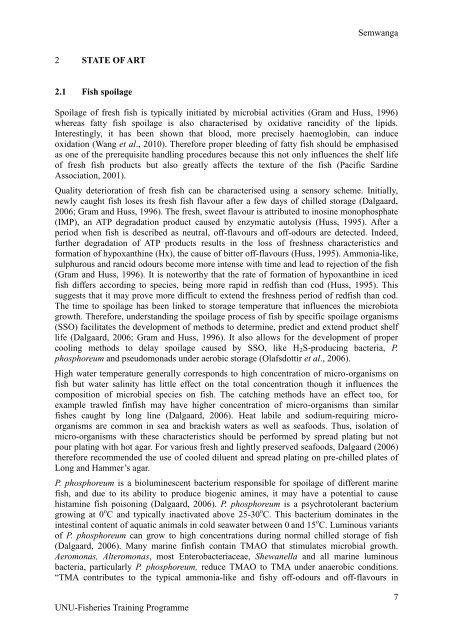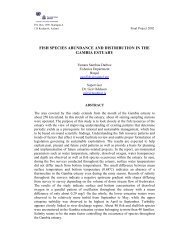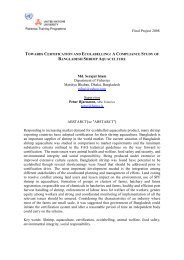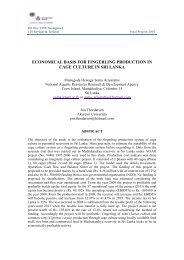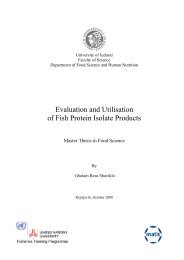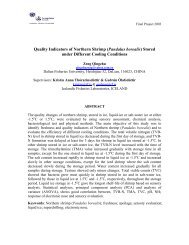THE EFFECT OF DIFFERENT COOLING TECHNIQUES ON THE ...
THE EFFECT OF DIFFERENT COOLING TECHNIQUES ON THE ...
THE EFFECT OF DIFFERENT COOLING TECHNIQUES ON THE ...
You also want an ePaper? Increase the reach of your titles
YUMPU automatically turns print PDFs into web optimized ePapers that Google loves.
Semwanga2STATE <strong>OF</strong> ART2.1 Fish spoilageSpoilage of fresh fish is typically initiated by microbial activities (Gram and Huss, 1996)whereas fatty fish spoilage is also characterised by oxidative rancidity of the lipids.Interestingly, it has been shown that blood, more precisely haemoglobin, can induceoxidation (Wang et al., 2010). Therefore proper bleeding of fatty fish should be emphasisedas one of the prerequisite handling procedures because this not only influences the shelf lifeof fresh fish products but also greatly affects the texture of the fish (Pacific SardineAssociation, 2001).Quality deterioration of fresh fish can be characterised using a sensory scheme. Initially,newly caught fish loses its fresh fish flavour after a few days of chilled storage (Dalgaard,2006; Gram and Huss, 1996). The fresh, sweet flavour is attributed to inosine monophosphate(IMP), an ATP degradation product caused by enzymatic autolysis (Huss, 1995). After aperiod when fish is described as neutral, off-flavours and off-odours are detected. Indeed,further degradation of ATP products results in the loss of freshness characteristics andformation of hypoxanthine (Hx), the cause of bitter off-flavours (Huss, 1995). Ammonia-like,sulphurous and rancid odours become more intense with time and lead to rejection of the fish(Gram and Huss, 1996). It is noteworthy that the rate of formation of hypoxanthine in icedfish differs according to species, being more rapid in redfish than cod (Huss, 1995). Thissuggests that it may prove more difficult to extend the freshness period of redfish than cod.The time to spoilage has been linked to storage temperature that influences the microbiotagrowth. Therefore, understanding the spoilage process of fish by specific spoilage organisms(SSO) facilitates the development of methods to determine, predict and extend product shelflife (Dalgaard, 2006; Gram and Huss, 1996). It also allows for the development of propercooling methods to delay spoilage caused by SSO, like H 2 S-producing bacteria, P.phosphoreum and pseudomonads under aerobic storage (Olafsdottir et al., 2006).High water temperature generally corresponds to high concentration of micro-organisms onfish but water salinity has little effect on the total concentration though it influences thecomposition of microbial species on fish. The catching methods have an effect too, forexample trawled finfish may have higher concentration of micro-organisms than similarfishes caught by long line (Dalgaard, 2006). Heat labile and sodium-requiring microorganismsare common in sea and brackish waters as well as seafoods. Thus, isolation ofmicro-organisms with these characteristics should be performed by spread plating but notpour plating with hot agar. For various fresh and lightly preserved seafoods, Dalgaard (2006)therefore recommended the use of cooled diluent and spread plating on pre-chilled plates ofLong and Hammer’s agar.P. phosphoreum is a bioluminescent bacterium responsible for spoilage of different marinefish, and due to its ability to produce biogenic amines, it may have a potential to causehistamine fish poisoning (Dalgaard, 2006). P. phosphoreum is a psychrotolerant bacteriumgrowing at 0 o C and typically inactivated above 25-30 o C. This bacterium dominates in theintestinal content of aquatic animals in cold seawater between 0 and 15 o C. Luminous variantsof P. phosphoreum can grow to high concentrations during normal chilled storage of fish(Dalgaard, 2006). Many marine finfish contain TMAO that stimulates microbial growth.Aeromonas, Alteromonas, most Enterobacteriaceae, Shewanella and all marine luminousbacteria, particularly P. phosphoreum, reduce TMAO to TMA under anaerobic conditions.“TMA contributes to the typical ammonia-like and fishy off-odours and off-flavours inUNU-Fisheries Training Programme7


